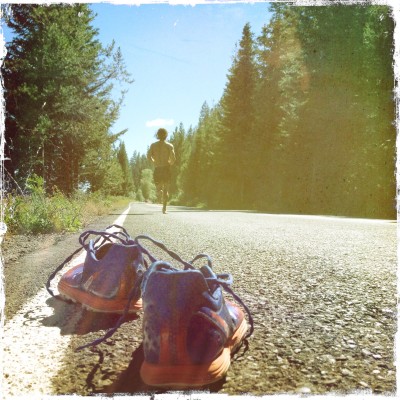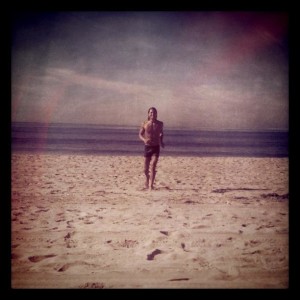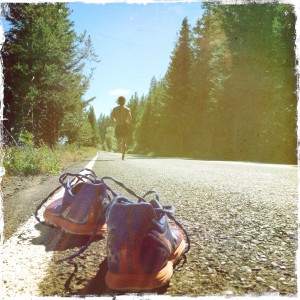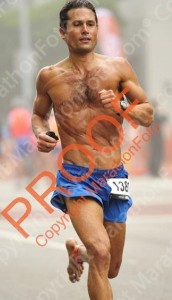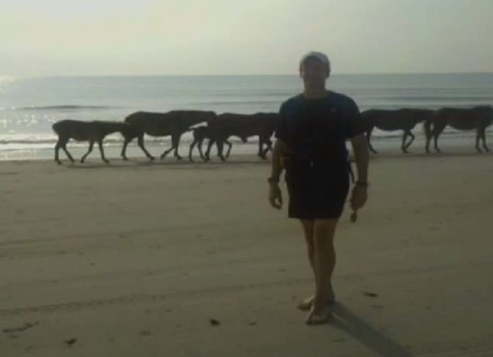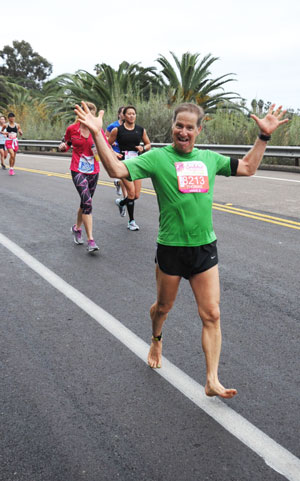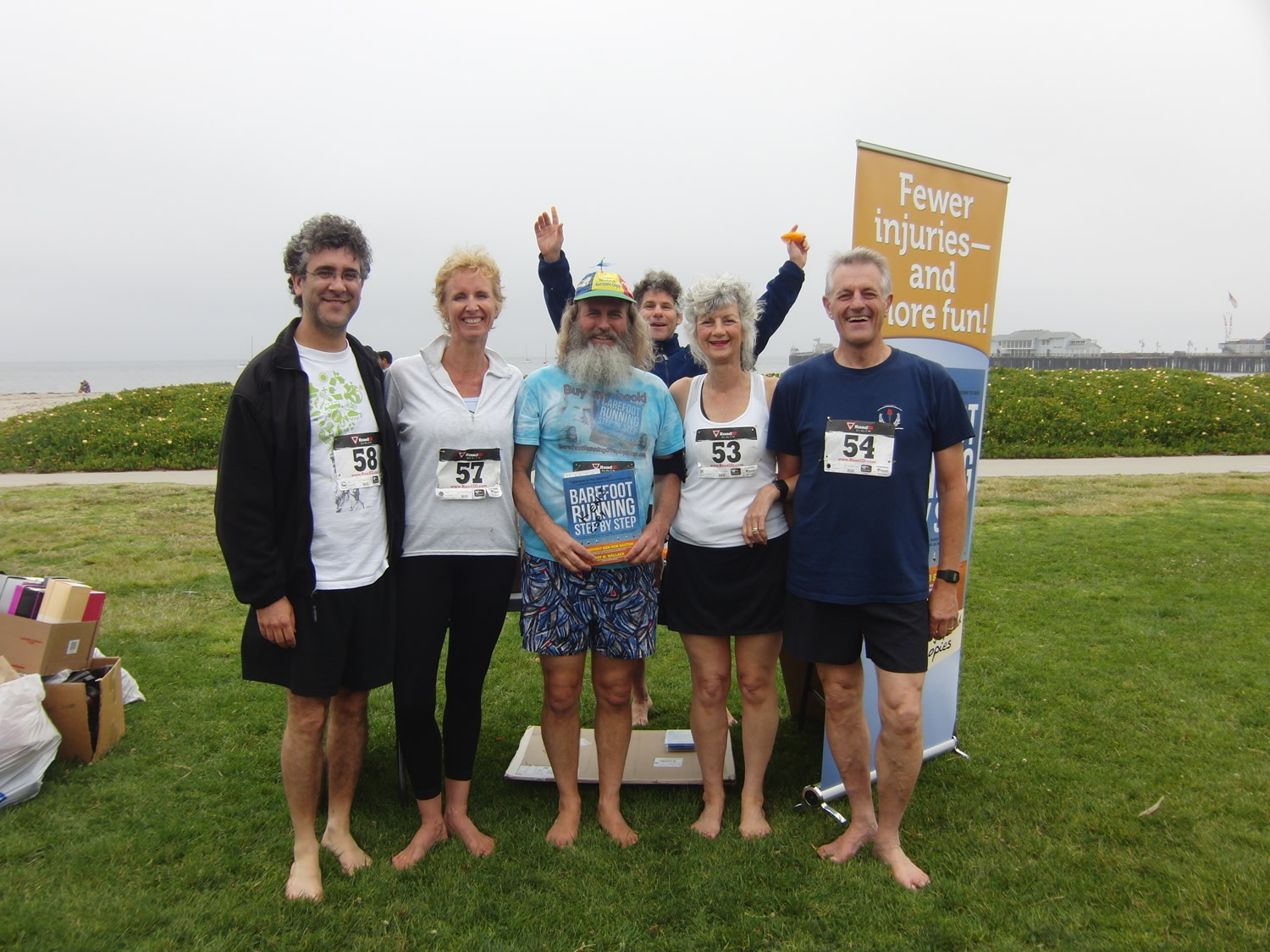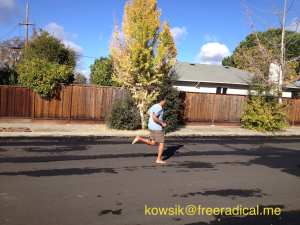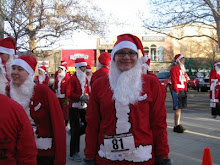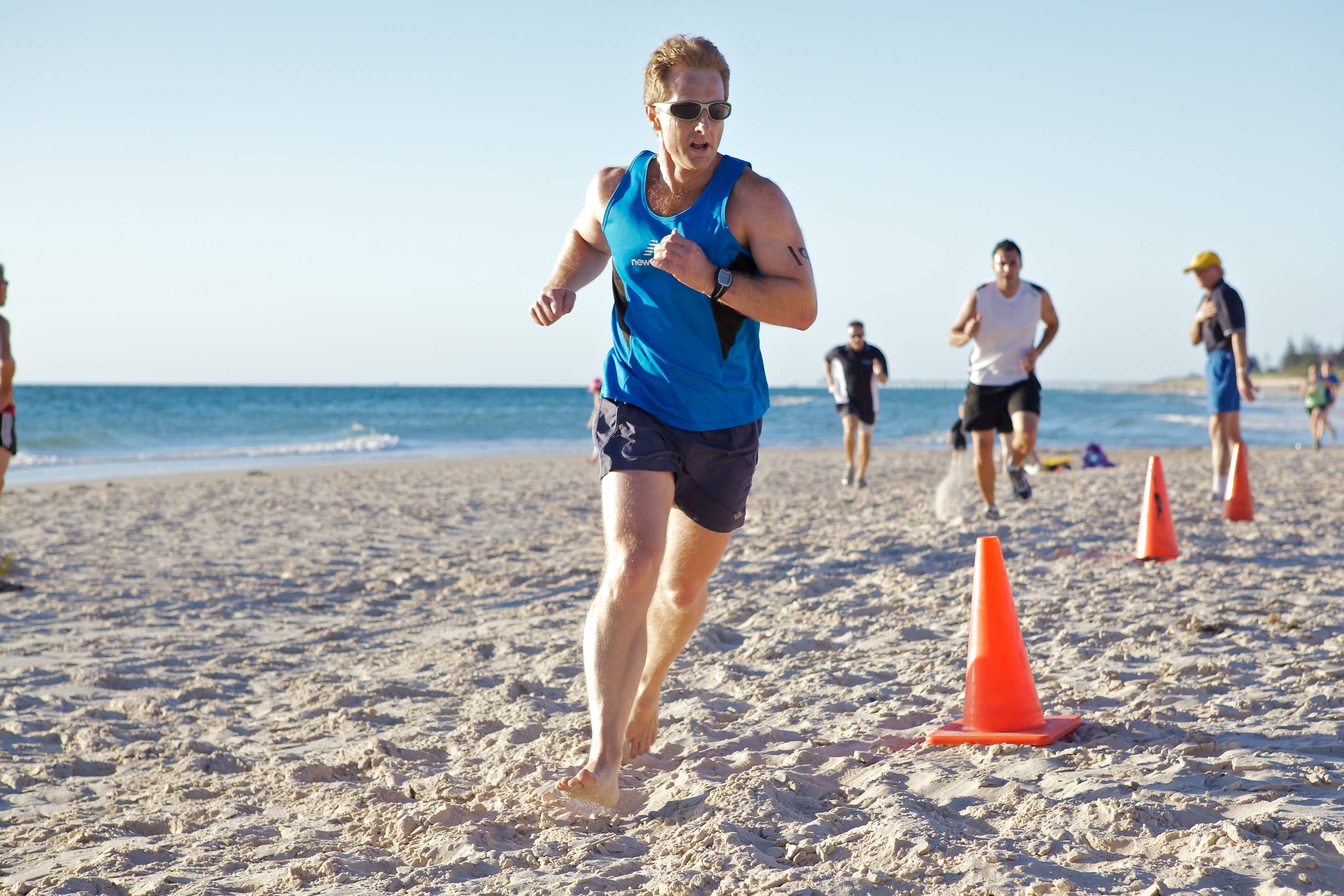A Thing or Two about Form
by Adam Dave, MD
Summary
Like so many others I happened upon barefoot running in the pages of the momentous Born to Run. It was in that book that I read about the Tarahumarans and their epic runs and their huaraches. I paid careful heed as the author, Chris McDougall, listed the many risks associated with running in shoes, especially the bulky modern ones with fancy names like motion control and pronator support and extreme stability etc. If nothing else there is the issue of weight.
Story
Consider that the lightest racing flats weigh about 8 ounces per pair. That’s half a pound. Now consider that a runner takes 160 or so steps per minute, and that comes to 40 pounds a minute of added weight you can do away with simply by running in your birthday shoes.The conclusion seemed pretty clear: Running without shoes had to be easier than running with shoes. I was intrigued. This was in 2010.
Wait, no, let me take a step back. My real first exposure to barefoot running came when I ran barefoot. The first time I ran barefoot – as an adult; as a kid I ran around unshod all the time, what kid doesn’t? – was at two in the morning, drunk. I was in medical school at the time and my roommates and I were at a beach party. I had consumed a sea of beer, which necessitated regular visits to the bathroom. The party came to an abrupt end and my roommates hopped into a car and took off without waiting for me to finish my business. They were pretty drunk, too. Left alone on the beach, I decided to hoof the half mile back to our house. (I went to med school on a small island in the West Indies, where pretty much everything could be reached on foot.) I was wearing flip-flops, which never fail to give me shin splints, so I took them off, tucked them into my linen pants, and broke into a trot. It was 2 a.m., and pitch dark, and none of that mattered because it felt great to run without shoes – or maybe because I was drunk? Anyway, to my surprise my feet held up pretty well. No blisters, glass bits, or bruises. I had expected them at least to be blackened from so many steps on the asphalt, but no. And I wondered: Does drunk running improve form, or is there something to this barefoot business?
A few years after my besotted foray into barefooting, one steamy summer afternoon in Los Angeles, I was running along and suddenly my feet felt all hot and bothered, but not in a good way. It was either stop running, or take off my shoes. I never stop running. And so I deposited my K-Swiss trainers in the bushes, and ran the 4 miles home wearing socks and feeling free. By the time I got home my socks were in tatters and both feet had blood blisters the size of silver dollars. For three days I couldn’t walk without a wince. It seemed I had a thing or two to learn about form.
So I bought a book on barefoot running (Ken Bob Saxton’s Barefoot Running Step by Step), read it cover to cover, and had a few good belly laughs. If regular barefoot running was as fun as reading about it, I was in. If nothing else, I needed a change.
Running had begun to feel tired and stale, not to mention a pain in every joint from my knee to my neck. But if I were to lose the shoes, I’d first need to do something about those nasty blisters. Clearly I was pushing off or pivoting or doing something to cause all that friction and fluid collection, and because one foot (my right) was more banged-up than the other, I was obviously running lopsided. Did I have a leg-length discrepancy? Gluteal weakness, which can cause the opposite hip to sag? Achilles tendonitis, plantar fasciitis, hip bursitis.sacroiliitis? Over the years I had had all of those conditions, and all while running with shoes. Were my running shoes to blame? I looked at the evidence– which, convincing pro-barefoot arguments made by Dr. Daniel Lieberman of Harvard aside – is, shall we say, equivocal. A pair of scientists from the Human Performance Laboratory at the University of Calgary pretty much sum up the shod versus unshod debate as it currently stands: “It is not known whether people running barefoot have more, equal, or fewer injuries than people running in conventional running shoes.”
And to my consternation, the researchers found that the additional weight of a shoe doesn’t seem to have much effect on performance one way or the other. So much for my theory.
Whether or not running shoes were to blame for my history of running-related injuries, the blisters were convincing proof of one thing: I had been overzealous in my first attempt at naked running. After so many years of wearing shoes nearly every waking hour, my feet were as smooth as a baby’s backside. Which had been a point of pride until now. Now, I needed padding, and over the next few months or years or however long it would take, I’d have to develop some, shall we say,epidermal cushioning. And I learned that it’s better to start with shorter distances measured in feet or yards rather than in miles, and preferably on grass rather than the rough and rocky road leading to my house.
Armed with knowledge and know-how, I embarked on my barefoot experiment, the goal of which was to determine one thing: Not whether running unshod was better for me, but whether it would make me faster. My previous best in the half marathon, a 1:18:50 clocked when I was 34 and already old by runners’ standards, was disappearing into the ever-distant past despite all my efforts to improve with age. Intervals, tempo runs, long runs, increased mileage, extra sleep, nutritional tweaks – I had done it all, and throughout I’d watched my race times slow or stay the same. (I was at that point stuck at 1:21).
As I logged more and more miles in my naked feet, sometimes taking my racing flats off mid-run, other times exiting the front door sans shoes, I noticed a few things. First, I could only run as fast as my feet would allow. If they hurt, whether because of too many miles or unfriendly terrain, I’d have to run more slowly, more softly, bending my knees and hips to allow these joints to act as shock absorbers. Gone were the days I could with abandon launch forward, smashing my heel into the pavement and sending shock waves reverberating through my skull. It was as if I had been running with the volume turned off, muting the sensations that my feet, with more nerve endings per square inch than anywhere else in the body other than perhaps the lips and fingertips, were designed to pick up – and did pick up, now that there was nothing more between them than God’s good earth, or more often, cement. Which is another thing. Humans may have evolved over millions of years running without shoes, but concrete is a modern invention and it sure can hurt! Maybe that’s why they invented shoes… But I kept on.
Other things changed. I ditched my iPod and doffed my watch. These gadgets didn’t seem to fit the minimalist look. I let my hair grow out. I grew a beard. I sold my car. I started eating most of my meals raw. In short, my whole life was changing, all because of footwear discarded.
As the miles piled up, I happened upon an interview filmed at the finish line of the Chicago Marathon. The interviewee was Julian Romero, a young guy from Indiana who had just completed the event without shoes, without even his own bib, it turned out. Romero sheepishly confessedto the newscaster that he had purchased the race number on Craig’s List the day before. Julian had gone from running with shoes to competing in marathons barefoot in just three months. This became my goal. I began running barefoot regularly in July of ’11, and by Halloween I completed a half marathon without shoes, running it in 1:24 – six minutes slower than my personal best but, hey, at least I finished, which was my goal.
In preparation for the race I had progressed to running 10 miles four times a week in the Hollywood Hills, all of it unshod, and once again this turned out to be too much too soon. The blisters persisted, but I persisted in my efforts. Two months later, I ran a beach boardwalk marathon without shoes in 3:24, but afterwards I could hardly walk my feet were so sore. So I started wearing running shoes again. But there is something about the allure of barefoot running. The feel of the wind through your toes, the feedback your feet receive from the ground. There is no other way to say it: Running without shoes is an experience like no other.
After a few months back in racing flats, the blisters had healed, and so the shoes came off again. But again I overdid it, and before long I was logging 80 miles a week, 40 of them without shoes. A stress fracture followed – in November of 2012 – which kept me away from running for 3 months. Did barefoot running cause or contribute to my broken metatarsal? Who knows. I think I was vitamin D deficient (it was after all, nearing winter) and my bones weren’t as strong as they should have been, but maybe that’s just a flimsy excuse. It certainly is true that my barefoot experience the first couple years could be characterized by a series of fits and starts, punctuated by injuries and overkill.
So this past April, when once again I doffed the shoes, I decided the third time would be a charm, or bust. I resolved to listen to my body, to take days off when necessary, to wear shoes (zero drop, 6.5-oz New Balance that are like socks with Vibram soles) when my feet were sore, and to run softly, even, dare I say, slowly.When you run fast, your form naturally corrects itself, while running slowly often means running sloppily. And I noticed many sloppy things about my form. I dextrorotated, a fancy way of saying I swung my right arm excessively. My head tilted back and I lost my neck in my shoulders. My entire torso leaned back, essentially putting on the brakes with every step. And yes, my hip did sag. In short, my form was a mess! Form shworm, I said. I’d just run fast and let the problems right themselves. I visited the UCLA track, since the soft polyurethane is a boon to bare-bottomed feet, and ran as fast as I could. Mile repeats, 800s. Even ten-mile tempo runs. How else to beat my personal best marathon and half marathon times without shoes?
I knew I’d never be a really fast runner (my best 10K time is 10 minutes slower than what the professionals clock). But with some work, I could be a really fast barefoot runner. That’s because hardly anyone runs without shoes, and the majority of those who do run barefoot do so to prevent or reduce injury, and they tend to run, well, leisurely. It goes without wearing a watch, Iguess. In fact, a fast barefooter is anomalous to the point of being oxymoronic. Other than AbebeBikila, who won the 1960 Olympic marathon held in Rome in a time of 2:15, and Julian Romero, who has logged several sub-3:00 marathons, even dipping intothe 2:30s, the number of guys who have run a marathon in under three hours in their bare feetcould be counted on the fingers of one hand, maybe two. In other words, not many.Nevertheless a new class is emerging to join the ranks of “overall” and “age group” winners, though thus far hardly a runner enters it. Which means that if you are unlikely to ever win a traditional race, even by running under three hours – consider that a time of 3:00 in the New York Marathon would have earned you just under 1000th place – if you take off your shoes, suddenly you’re in a league of your own, instantly one of the top (maybe the only) finishers in this new class.
This past October I took my place amidst a field of swift athletes at the Los Angeles Rock ‘n’ Roll Half Marathon in my now customary attire: no shirt, short shorts, and no shoes. I started slowly, at maybe a 6:10-minute mile pace. At the 10K marker, my feet felt good, and so I turned it on a bit. By mile 10, I felt breezy, and though I barely made the top ten, the shouts and cheers from other runners who espied my naked feet made me feel as though I had won the race. I crossed the finish line in a personal best 1:18:22, slicing a precious 30 seconds from my previous record. A couple weeks later I followed this up with a personal best 2:49 at the Malibu Marathon– in May I had run a 2:51 wearing shoes, so that was the time to beat – and again I did it barefoot. At this race they awarded special prizes to the top three barefoot runners, and you can guess who finished first.
Now I am officially a faster runner barefoot. Is it because my form is better and my feet are stronger, or is it merely some novelty effect inspired by all the attention I get from being as anomalous as the guy dribbling basketballs, the guy juggling tennis balls, and the guy wearing an Elvis costume?
Is itbetter to run barefoot? That may not be the right question to ask. More important, at least in terms of performance and injury, is the curiously-unscientific “subjective preference.” In the end, even scientists agree that runners run best when they’re comfortable, whatever they happen to wear (or not to wear).
As for me, I’ll have to log a few more miles with and without shoes to determine which way is preferable. I will say that after my record-setting 26.2-miler my body felt great – from the ankles up. I could actually bend my knees after the race, a first for me. Unfortunately, my feet looked a bit like hamburger meat.
I guess I still have a thing or two to learn about form.
